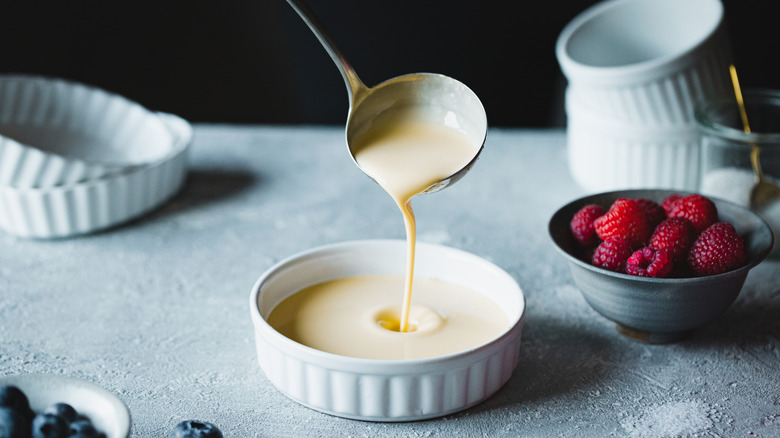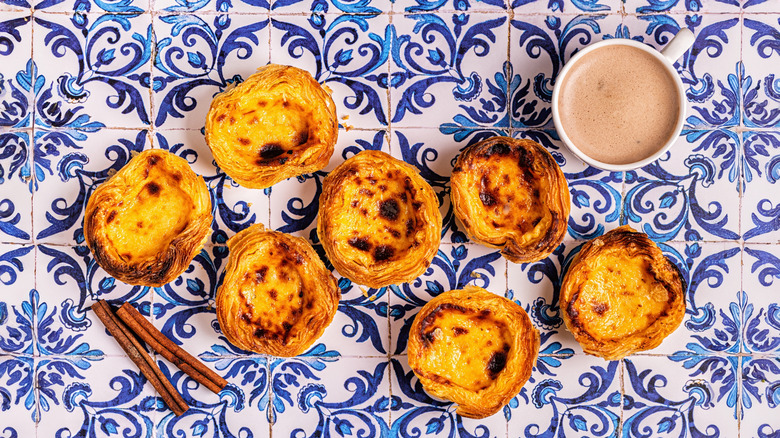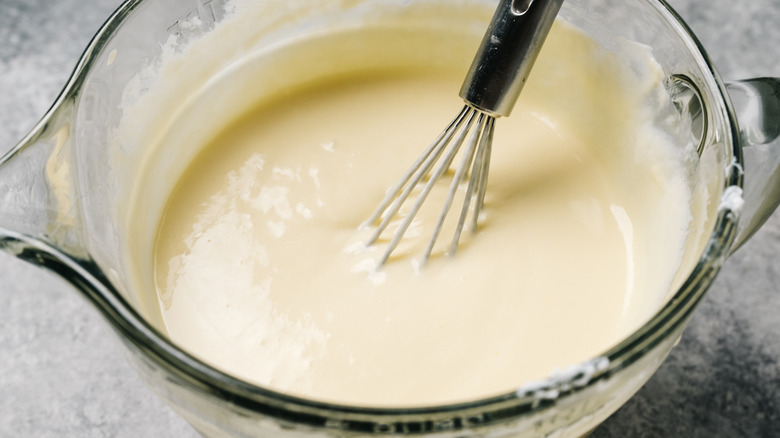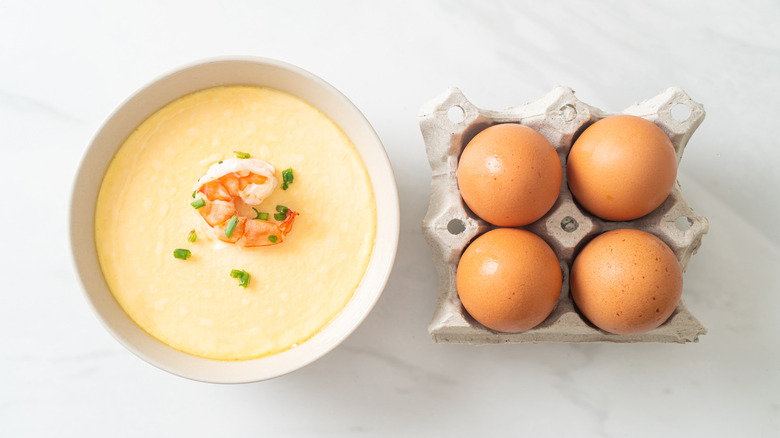3 Common Types Of Custard And How They Differ
Custard, by its most basic definition, doesn't sound all that exciting: a dish made from a simple blend of eggs and milk (or cream). But as any chef or dessert enthusiast will tell you, custard is so much more than that. The name "custard" doesn't do justice to the vast family of dishes and recipes that bear it. From filled pastries to ice creams to a wide array of savory dishes, custard forms the foundation of some of our favorite culinary creations. There are many types of custard, but three in particular are the most likely to appear in your kitchen: baked custards, stirred custards, and steamed custards.
Though they share the same culinary roots in that simple blend of egg and milk, each type is distinct in taste, texture, and preparation — and, of course, in how they are eaten. Baked and stirred custards, for example, are closer to what most people in the United States consider a stereotypical "custard." These have a long history in Western culinary traditions; they are typically sweetened and often infused with spices like cinnamon or vanilla before being used as toppings or fillings for a variety of desserts — or simply enjoyed on their own. Steamed custards, meanwhile, are more common in Eastern cuisine, and are enjoyed both sweet and savory, at any time of day (not just for dessert, as is most common in the West). But that's only where the distinctions begin.
Baked custards
Baking is one of the most popular methods for making custards, and serves as the basis for some of the finest desserts, from the iconic Portuguese egg tart, pastel de nata, to the French classic crème brûlée. While baked custards are most commonly used in sweet dishes, they also shine in savory preparations. The French, once again, come out swinging here, infusing their baked custards with bold flavors like brie and onion. Baking custard involves cooking the base mixture of eggs and milk (or cream) in a low oven, typically at around 350 degrees Fahrenheit — though this can vary. The pastéis de nata, for example, are often recommended to be baked at the highest temperature your oven can reach.
Baked custards are often firmer in texture than other types. You can tell if they're set by gently tapping the dish or pan in which they were baked; a properly cooked custard will stick to itself and jiggle slowly when moved. This characteristic firmness comes from the ingredients, as baked custards are often made with whole eggs instead of just yolks, which are more commonly used in other types of custards for a richer flavor and texture. Additionally, baked custards have a significantly higher egg-to-liquid ratio, helping them achieve their firmer texture. They're not just firmer but also thicker, as they are typically left undisturbed during cooking, unlike stirred custards, which are — as the name implies — continuously stirred.
Stirred custards
The undisputed kings of stirred custard are, unsurprisingly, the French. In fact, it was they who gave custard its name: French custard tarts called croustardes (a reference to their crusts) became popular in England during the Middle Ages, eventually becoming known as custards — and an icon was born.
Many of the best-known stirred custards are of French origin. Crème anglaise, for example, has a consistency similar to heavy whipping cream, and is often flavored with vanilla. It's pourable, making it perfect for pairing with other desserts, like a classic apple, maple, and pecan crumble. There's also crème pâtissière, the ideal filling for pastries like éclairs or mille-feuilles. This custard is often stabilized and thickened with ingredients such as cornstarch or xanthan gum, which add thickness without altering the flavor.
Stirred custards are likely what springs to mind when someone says "custard." They are, as the name suggests, stirred (or whisked) constantly throughout the cooking process, unlike baked or steamed custards, which are left undisturbed to set as they cook. This continuous stirring is what defines their texture and really sets them apart (if you'll forgive the pun). Even the thickest stirred custards, such as the aforementioned crème pâtissière, don't achieve the firm set of something like a pastel de nata. They are also typically made with egg yolks rather than whole eggs, as in baked custards, giving them a rich and creamy flavor.
Steamed custards
Steamed custards are notably distinct from baked and stirred custards — not just in their preparation method, but also in their core ingredients. Steamed custards are more common in Asia than in other parts of the world, where dairy is less prevalent in traditional diets. As such, instead of dairy, these custards often use broth or stock (sometimes vegetarian, sometimes not) or plant-based alternatives like soy milk.
The Japanese chawanmushi (meaning "steamed cup"), for example, is a deliciously savory custard made with soy sauce and mirin, and instead of dairy, it uses dashi. This custard is steamed in a teacup and topped with a variety of meats and vegetables once set. A cousin of the chawanmushi is the Korean gyeranjjim, often eaten as a side dish and simply prepared with green onions and sesame. Traditional Chinese steamed eggs are even simpler, made with a mix of egg and water, then steamed in the same way. You can still find sweet steamed custards — Thai versions, for instance, sometimes use creamy coconut milk, lending the custard a fresh, nutty sweetness.
Steaming custards can also produce a better, more foolproof texture. The gentle, indirect heat of steam — as opposed to the harsh, dry heat of an oven — helps reduce the risk of overcooking or, worse, curdling the custard. This results in a smoother, silkier, and more delicate texture.




